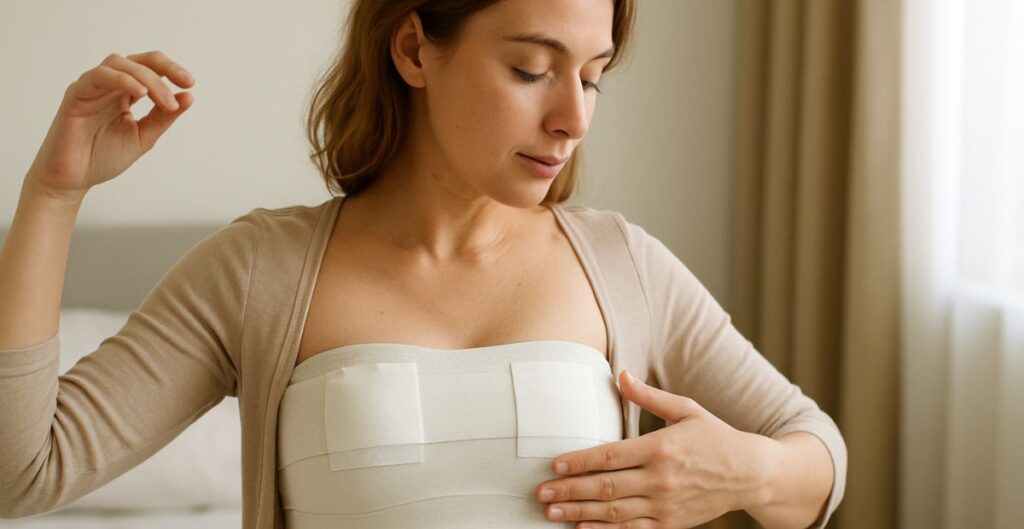If you want to lose belly fat after breast reduction, the key is combining healthy eating, gentle exercise, and gradual recovery so you protect your surgical results while still working toward your fitness goals.
Breast reduction surgery can be life-changing, giving you relief from back pain, shoulder strain, and discomfort. But some women notice unexpected changes in their body shape afterward especially around the midsection. This can be frustrating, especially if your stomach looks bigger after breast reduction or you feel you’ve gained weight. Let’s explore why this happens, and more importantly, how you can safely and effectively get rid of belly fat after breast reduction.
Why Does the Stomach Look Bigger After Breast Reduction?
One of the most common concerns after breast reduction is, “Why is my stomach bigger after breast reduction?” There are several reasons this can happen:
- Change in Body Proportion – When your breast size is reduced, your body’s proportions shift. Even if your waist size hasn’t changed, a smaller chest can make the stomach appear more prominent.
- Post-Surgery Swelling – Your body naturally retains fluids after surgery. While most swelling is in the chest area, fluid shifts and inactivity can also cause temporary bloating in the abdomen.
- Reduced Activity – In the first few weeks post-surgery, physical activity is restricted. Less movement can lead to water retention, reduced calorie burn, and mild weight gain.
- Weight Fluctuation – Some women report a 5lbs–20 lbs weight change after surgery, often linked to reduced movement or post-surgery eating habits.
Tip: Don’t panic if your stomach looks bigger during recovery this is often temporary and can be improved with the right approach once your surgeon clears you for activity.
Safe Post-Breast Reduction Belly Fat Loss with Expert Guidance
After a breast reduction, many women want to focus on safe and effective ways to lose belly fat. Combining balanced nutrition and low-impact exercises can speed up recovery and fat loss. According to Harvard Health, regular walking not only burns calories but also improves blood circulation, which is crucial for healing. Adding core-strengthening workouts recommended by Mayo Clinic can help tighten the abdominal area. For personalized dietary plans, resources like CDC Healthy Weight offer evidence-based tips. Always follow your surgeon’s advice before starting any workout to ensure safety and prevent post-surgery complications.
When Can You Start Walking After Breast Reduction?
Walking is one of the safest and most effective ways to slowly reintroduce movement after surgery. Most surgeons recommend light walking within a few days to promote circulation and reduce swelling, but this should be gentle and slow.
- Week 1–2: Short, slow walks around your home to prevent stiffness and improve blood flow.
- Week 3–4: Gradually increase distance but still avoid brisk walking or inclines.
- After Week 4: If your surgeon approves, you can start faster-paced walking, which is great for burning calories and reducing belly fat.
Important: Avoid heavy exercise or abdominal workouts until you are fully healed (usually 6–8 weeks), to protect your stitches and prevent complications.
How to Get Rid of Belly Fat After Breast Reduction
Once you’re cleared for normal activities, you can focus on targeted fat loss strategies. Remember: You can’t spot-reduce fat, but you can burn overall body fat, which will eventually slim your midsection.
1. Adopt a Balanced, Calorie-Controlled Diet

Focus on nutrient-rich foods to support healing and fat loss:
- Lean proteins (chicken, fish, lentils, eggs)
- High-fiber vegetables and fruits
- Whole grains (oats, brown rice, quinoa)
- Healthy fats (olive oil, nuts, avocado)
Avoid processed sugars, refined carbs, and excess salt these can contribute to belly bloating.
2. Start with Low-Impact Cardio
Once fully recovered, aim for 150 minutes of moderate cardio weekly:
- Brisk walking
- Stationary cycling
- Swimming
These burn calories without stressing your surgical scars.
3. Incorporate Core-Strengthening Exercises
After clearance from your surgeon:
- Pelvic tilts
- Seated marches
- Bird-dog exercise
These build abdominal strength, improve posture, and enhance your new body shape.
4. Stay Hydrated
Drinking enough water supports metabolism and reduces fluid retention, which can make your belly look smaller.
5. Get Adequate Sleep
Poor sleep increases cortisol (a stress hormone) which is linked to belly fat gain.
20 lb Weight Loss After Breast Reduction – Is It Possible?
Some women find it easier to lose weight after breast reduction because exercise becomes more comfortable and less painful. A 20 lb weight loss is absolutely possible over time with consistent healthy habits. However, rapid weight loss should be avoided early in recovery, as your body needs energy for healing.
Key Takeaways for Losing Belly Fat After Breast Reduction
- Wait for your surgeon’s approval before starting workouts.
- Begin with gentle walking, then progress to cardio and strength training.
- Eat a balanced, whole-food diet to promote healing and fat loss.
- Focus on long-term consistency rather than quick fixes.
You should also read this:
- If you’re struggling with midsection fat, you may also like our guide on How to Lose Lower Back Fat for additional targeted tips.
- For faster results, check our Tummy Fat Loss Drink ideas that are safe post-surgery.
- If weight gain is your main concern, our How to Lose 5lbs in a Week guide can help you kickstart the process

